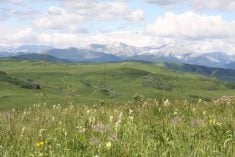The discovery of clubroot in two corporate disease nurseries in Saskatchewan has prompted the Canadian canola industry to review the way canola seed companies manage research facilities in Western Canada.
Cargill Canada has confirmed that clubroot has been identified at two of the company’s disease nurseries in north-central Saskatchewan.
Company officials and provincial disease experts with Saskatchewan Agriculture said last week that the exact locations of the infected facilities would not be disclosed because of privacy issues.
But independent sources that asked to remain anonymous toldThe Western Producerthat one of the infected nurseries is located near Aberdeen, about 30 kilometres northeast of Saskatoon, where the company develops and tests specialty oil varieties.
Read Also

Gene editing digs deeper space in Canadian plant breeding
More Canadian research into crop variety development is incorporating gene editing, and one researcher notes that Canada’s regulatory approach to gene editing will help drive innovation
Lorin DeBonte, assistant vice-president of research and development for Cargill Specialty Oils, confirmed that the two infected nurseries are located in two different Saskatchewan municipalities.
To drive from one nursery to the other would take two hours, he added.
Cargill has been working with Saskatchewan Agriculture, the Canola Council of Canada and local farmers to ensure the disease is contained, he added.
“Upon discovering the presence of clubroot, we notified grain growers and owners of lands around the disease observation nurseries and provided them with the guidance and resources they required to manage the issue in a timely and cautious manner,” DeBonte said.
The discovery of clubroot in Cargill research plots has the canola industry reviewing management protocols for research facilities owned or operated by canola development companies.
According to DeBonte, Cargill plant scientists discovered clubroot-infected plants while analyzing Cargill’s unregistered canola cultivars for resistance to blackleg, another common canola disease.
To analyze new cultivars for blackleg resistance, companies typically identify production areas where blackleg is a prevalent concern, establish a disease nursery in that vicinity and then crop canola continuously to ensure that disease levels in nursery plots are consistently high.
However, cropping canola continuously creates an ideal environment for the spread of clubroot.
Growing canola on the same land in back-to-back years is strongly discouraged by the Canadian canola industry and by Saskatchewan’s provincial clubroot management plan.
Commercial canola growers are encouraged to plant canola once every four years.
In some instances, companies looking to increase blackleg pathogen levels in a blackleg nursery will collect infected plant material from one area and transport it to an established disease nursery in another area.
“In order to build the disease (levels) up, you typically are finding locations or farmers’ fields where they’ve had blackleg infestations or you’re collecting specific plant materials from those fields that have been infected and you’re bringing those materials to your nursery areas so that you have a good inoculum of disease to infect your plants,” DeBonte said.
Transporting plant material and soil from one area to another is also discouraged in the province’s clubroot management plan.
DeBonte said Cargill conducted soil tests at the infected sites before establishing its blackleg nurseries. Those soil tests showed no sign of the clubroot pathogen.
“What we believe is that (it was there) … at such a low level that it was not detectable.”
DeBonte said research companies that operate disease nurseries typically follow management guidelines that include setback distances from neighbouring crops, restrictions on access and procedures for disinfecting machinery and vehicles that enter or leave the sites.
He acknowledged that in some instances, management protocols for corporate research facilities appear to be out of sync with provincial clubroot plans for commercial canola growers.
Cargill will work with Saskatchewan Agriculture, the Canola Council of Canada, academics and other canola companies to review procedures and develop new protocols to ensure that research efforts are not contributing to Western Canada’s clubroot problems.
” This will be addressed by industry,” DeBonte said.
Faye Dokken-Bouchard, a plant disease specialist with the province, said Saskatchewan Agriculture will be working with Cargill and the two affected RMs to develop local management plans.
Farmers will also be encouraged to follow best management practices that prevent the spread of the disease.
The province does not anticipate restrictions on commercial canola production in the affected RMs but will encourage growers to follow four year rotations and take other necessary precautions.
“That (restriction on production) is not something that’s being required at this time,” said Dokken-Bouchard, who also chairs an industry group established to control the spread of the disease in Saskatchewan.
“We believe that our producers in Saskatchewan … will make the right decisions about their rotations.”
DeBonte said the discovery of clubroot in Cargill’s test plots means the company will lose a year’s worth of research data from its Saskatchewan test locations.
However, the setback is not likely to delay registration of Cargill’s newest specialty oil varieties because the company’s most promising cultivars are usually tested and screened in all three prairie provinces.
———
subscriber section=news, crops, none















